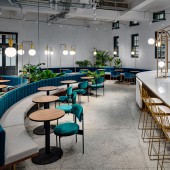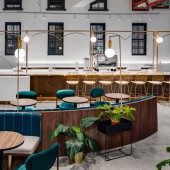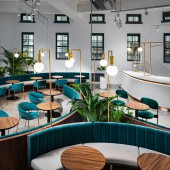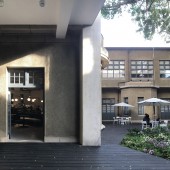
| THE AWARD |
| CATEGORIES |
| REGISTRATION |
| SUBMIT YOUR WORK |
| ENTRY INSTRUCTIONS |
| TERMS & CONDITIONS |
| PUBLICATIONS |
| DATES & FEES |
| METHODOLOGY |
| CONTACT |
| WINNERS |
| PRESS ROOM |
| GET INVOLVED |
| DESIGN PRIZE |
| DESIGN STORE |
| THE AWARD | JURY | CATEGORIES | REGISTRATION | PRESS | WINNERS | PUBLICATIONS | ENTRY INSTRUCTIONS |
Revival Cafe by Yen, Pei-Yu |
Home > Winners > Design #103919 >Interview |
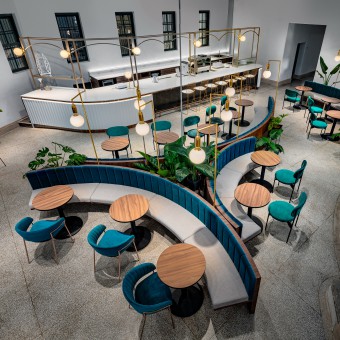 |
|
FS: What is the main principle, idea and inspiration behind your design?
PY: There are many issues we have to consider while preparing for a design project. To make a good design possible, we have to think about the building, environment, the user’s character, and so forth. The design of the Revival Cafe, for example, is under the constraints such as the expectation from the art museum and the building’s heritage status. One cannot begin the design without taking these conditions seriously.
FS: What has been your main focus in designing this work? Especially what did you want to achieve?
PY: I wanted to bring in a style that cannot be defined, a style that can respect the building’s heritage status and also echo the modernity of the new art museum. I want to use this cafe to demonstrate how a dialogue between the past and the future and also between the East and the West can be possible.
FS: What are your future plans for this award winning design?
PY: I will share this news with people who are involved with this project and announce this news to the general public.
FS: How long did it take you to design this particular concept?
PY: The concept itself took around a week and the drafting was about one day.
FS: Why did you design this particular concept? Was this design commissioned or did you decide to pursuit an inspiration?
PY: The design was commissioned, but the client left plenty of room for me to decide the style of the cafe.
FS: Is your design being produced or used by another company, or do you plan to sell or lease the production rights or do you intent to produce your work yourself?
PY: This is an interior design project which will only be used in this cafe.
FS: What made you design this particular type of work?
PY: The constraints on the floor area and space turned out pushing me to come out with interesting design.
FS: Where there any other designs and/or designers that helped the influence the design of your work?
PY: Shigeru Ban and Joe Shih.
FS: Who is the target customer for his design?
PY: public sector
FS: What sets this design apart from other similar or resembling concepts?
PY: The conditions related to the space are what make the design unique.
FS: How did you come up with the name for this design? What does it mean?
PY: It’s mainly from the special constraints and status of this project – a café that bears the memory of the past but has to serve for the customers who look for the future. This reminds me of the Chinese idiom from the Analects, new knowledge can be discovered from reviewing what one has known. For me, the cafe is like an instance of revitalization, and hence Revival Cafe.
FS: What is the most unique aspect of your design?
PY: The most unique part of the interior design is the the curve shaped chairs of different size that brought in smooth movement and beautifully solved the challenges such as the irregular flooring area and multiple entrances. They also offer the visitor of the cafe opportunities to enjoy the details of the heritage from different angles.
FS: Who did you collaborate with for this design? Did you work with people with technical / specialized skills?
PY: The design was solely done by me, but the construction was outsourced to other professionals.
FS: What are some of the challenges you faced during the design/realization of your concept?
PY: The most challenging part of the project is related to its heritage status. Due to the regulations in Taiwan, all of the main structure of a heritage should not be altered – this includes the ceiling, floor, and the wall. Besides, the irregular shape of the space also creates extra challenge to the project. Besides, the construction must not be in conflicts with the art museum’s opening hours; it also be very carefully planned so as the collections in the museum won’t be damaged by the construction. This was part of the reason many of the interior decorations had to be done outside the building and then assembled in the room later on. It’s really challenging to move around huge pieces in a heritage.
FS: How did you decide to submit your design to an international design competition?
PY: I want to share my hard work with others and hopefully gain some opportunities for future collaboration.
FS: What did you learn or how did you improve yourself during the designing of this work?
PY: It gave me a priceless opportunity to have an in-depth research on the traditional methods people used for constructing architecture in Taiwan. Without knowledge like how to keep the terrazzo floor’s horizon levelled, I wouldn’t have been able to overcome the challenges I faced during the implantation of my design.
FS: Thank you for providing us with this opportunity to interview you.
A' Design Award and Competitions grants rights to press members and bloggers to use parts of this interview. This interview is provided as it is; DesignPRWire and A' Design Award and Competitions cannot be held responsible for the answers given by participating designers.
| SOCIAL |
| + Add to Likes / Favorites | Send to My Email | Comment | View Press-Release | Translations |

